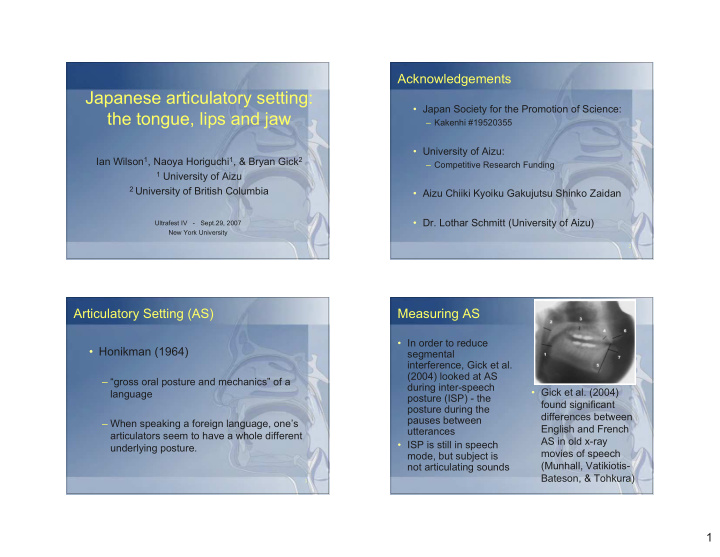



Acknowledgements Japanese articulatory setting: • Japan Society for the Promotion of Science: the tongue, lips and jaw – Kakenhi #19520355 • University of Aizu: Ian Wilson 1 , Naoya Horiguchi 1 , & Bryan Gick 2 – Competitive Research Funding 1 University of Aizu 2 University of British Columbia • Aizu Chiiki Kyoiku Gakujutsu Shinko Zaidan • Dr. Lothar Schmitt (University of Aizu) Ultrafest IV - Sept.29, 2007 New York University 2 Articulatory Setting (AS) Measuring AS • In order to reduce • Honikman (1964) segmental interference, Gick et al. (2004) looked at AS – “gross oral posture and mechanics” of a during inter-speech • Gick et al. (2004) language posture (ISP) - the found significant posture during the differences between pauses between – When speaking a foreign language, one’s English and French utterances articulators seem to have a whole different AS in old x-ray • ISP is still in speech underlying posture. movies of speech mode, but subject is (Munhall, Vatikiotis- not articulating sounds Bateson, & Tohkura) 3 4 1
Wilson (2006) Dissertation Wilson (2006) - Subjects • 10 monolingual Canadian-English speakers • Took the Gick et al. (2004) study farther, first (reduced to 7) replicating it and then using bilingual subjects – could compare across languages without worrying • 12 monolingual Québécois-French speakers about physiological differences between subjects (reduced to 8) • Used ultrasound to measure tongue position • 11 bilingual English-French speakers and Optotrak (optical tracking system) to (reduced to 9) measure lip and jaw position during ISP 5 6 Wilson (2006) - Stimuli Wilson (2006) - Apparatus used (1) • Monolingual subject trials: – 6 blocks of 30 utterances (= 180 rest positions per subject) • Bilingual subject trials: – 2 English blocks, 2 French blocks, 2 mixed language blocks 7 8 2
Wilson (2006) - Apparatus used (2) Wilson (2006) - Ultrasound data analysis 9 10 Wilson (2006) - Optotrak data analysis Results: Monolingual subjects (1) Tongue tip height Degree of lip narrowing • Jaw lowering • Upper & lower lip height • Upper & lower lip protrusion • Vertical and horizontal lip aperture • Degree of lip narrowing English higher English more narrowed 11 12 t (10.7) = 2.43, p = .0340 t (9.5) = 2.60, p = .0277 3
Results: Monolingual subjects (2) Selected Summary of Wilson (2006) Upper lip protrusion Lower lip protrusion • AS, as seen through ISP, differs across English and French groups – English tongue tip higher – English lips more protruded – English lips more narrowed from max spread • These results tested with bilinguals – Confirmed for lip protrusion – Somewhat confirmed for tongue tip height – Not confirmed for lip narrowing English more protruded English more protruded 13 14 t (10.3) = 2.64, p = .0242 t (11.0) = 2.83, p = .0163 The Present Study Method: Subjects • Data collected from 9 subjects, but only 7 subjects’ data was useable • Uses very similar methods to measure the AS for Japanese • All native speakers of Japanese with 6-7 years exposure to EFL in public school • Were paid and were unaware of purpose of experiment • Anatomical measure was used to normalize each subject’s data 15 16 4
Method: Stimuli Method: Data Collection • 4 trials of 30 short Japanese sentences each; • 3D positional data of 12 markers (3mm each trial had the same 30 sentences hemispherical) collected using Vicon MX rearranged in random order infrared motion capture system • 村田さんの趣味はゲーム (“Mr. Murata’s favorite pastime is playing video games.”) • Movies of tongue simultaneously collected with Toshiba Famio 8 ultrasound • Stimuli presented to subjects in automatic PowerPoint presentation, one sentence at a time 17 18 Method: Marker Placement Experimental Set-up: Vicon MX 19 20 5
MATLAB Analysis Results - tongue tip height • J<E [ t(11.55)=2.98 p=.0119 • J=F [ t(9.38)=1.29 p=.2292 • User indicates where the alveolar ridge is in a separate • F<E [t(10.69)=2.43 frame p=.0340 (from • MATLAB then opens pre-saved ISP frames and indicates Wilson 2006) where alveolar ridge would be • User clicks as close as possible to the hyoid shadow 21 22 • The resultant angle is trisected and user clicks on tongue Results - TB, TD, TR Results - Lips • Vertical lip aperture was not even close to • Japanese TB significantly lower than being significant in any lang. pair English and French (p=.0064; p=.0372) • Japanese upper lip protrusion was • Japanese TD significantly lower than significantly greater than French, but not English and French (p=.0503; p=.0346) English (p=.0303; p=.9112, respectively) • Japanese TR significantly lower than • Horizontal aperture unavailable, but lower lip protrusion data will be analyzed soon! only French (p=.0415) 23 24 6
Next Steps • Test the reliability of pinpointing the subject’s alveolar ridge. Do this using bite plane data. • Figure out what determines a language’s AS. • Test whether AS is different for natural speech vs. read speech, nonsense words vs. real words. (i.e. Test whether AS is task dependent.) • Test what is perceptually salient in AS (i.e. if learned, how it is learned?) Test how much can be read in the face. 25 7
Recommend
More recommend